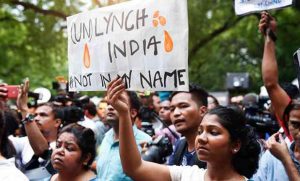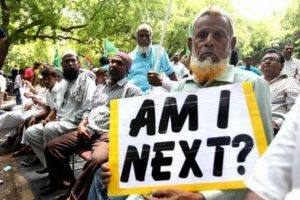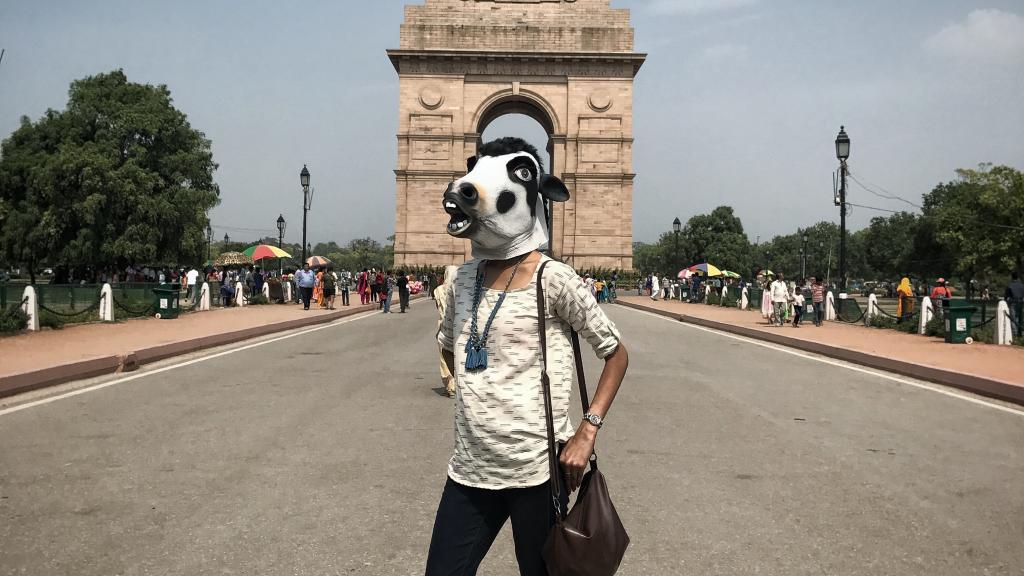“If any person indulges in cruelty to cows (leave aside talking of killing of cows), he will find himself behind bars.”
These were the big words said by our very own cow-loving, Chief Minister of Uttar Pradesh, Yogi Adityanath. In his quest to make India understand that cows’ lives matter, Adityanath has spent considerable amount of time feeding the cow, petting the cow and urging India to delve into its humanity and stop the killing of their mother or “Gau Mata”.
As the CM of UP wages a battle to protect the mother of the nation, ironically, UP sees a rise in the number of rapes from 3,419 in 2016 to 4,246 in 2017. Rapes have been on a rise in UP much more than during the regime of Akhilesh Yadav. As Yogi Adityanath raises his voice against the heinous crimes against Gau Mata, there seems to be a deafening silence when it comes to sexual assault against women.
Also read: On Mob Lynchings, Silence And The State of India’s Conscience
UP can be seen as a microcosm for the entire country under the rule of Prime Minister Modi which has witnessed a normalisation of, and rise in, two things simultaneously – cow vigilantism and rape. This creates a huge contradiction in our country today. As crimes against women rise, more attention is instead given to protection of the cow, which in itself is a symbol of motherhood and femininity.

Image Source: India TV
Further, this quest to protect the cow has also been one not devoid of bloodshed and crime against women. As the presence of cow vigilantes increases, crimes such as mob lynchings, murder, harassment and ironically even rape, continue to increase. For example, in 2016 a young Muslim woman and her cousin were gang-raped by a group of cow vigilantes based on the mere suspicion that they eat cow meat. In a statement the young woman said that:
“They (the accused men) said that we ate cow meat and that is why we are being disgraced (raped). They threatened to kill me and my family if we ever told anybody what happened to us.”
As Yogi Adityanath raises his voice against the heinous crimes against Gau Mata, there seems to be a deafening silence when it comes to sexual assault against women.
Emboldened by the Modi government, cow terror attacks have become more blatant than ever. A report by India Spend states that:
“97% of all cow-vigilante attacks reported since 2010 took place after the Hindu-nationalist Bharatiya Janata Party (BJP) came to power in 2014, with Narendra Modi as Prime Minister. Most have targeted Muslims and Dalits (formerly known as untouchables), who traditionally skin the carcasses of cows.”
Relegated to the position of ‘Mother’, the cow has become a symbol that needs to be understood in order to make sense of the current, contradictory climate of India. The feminisation of the cow becomes a tactic similar to that of feminising the nation; both Bharat Mata and Gau Mata have become grounds to legitimise attacks on minorities, terrorise the body of lower caste women, and consolidate the power of the upper caste Hindu man in Modi’s India. Cow vigilantism has become the norm.
The cow in Hinduism has always represented not womanhood, but specifically motherhood that the Hindu right has sworn to protect. Aditi is a goddess in Rig Veda mentioned nearly 8 times, and is equated to the symbol of the cow. While her character is undefined, she mainly occurs as a mother figure – mother of Indra, mother of kings, and God. She is asked to protect the one who petitions her and provide blessings and wealth. Aditi, provides nourishment, her milk is redemptive and is seen as soma, an invigorating drink. In the Rig Veda a passage on Aditi goes as follows:
“Mother of the Rudras, daughter of the Vasus, sister of the Adityas, navel of the nectar (immortality) — to one who can understand let me proclaim this, ‘Injure not the guiltless cow Aditi!’
[Then Aditi speaks:] ‘Me, who know the spell, raising up the sacrificial voice inherent in all pious devotions, a goddess arrived from the gods, me, the cow, the mortal of slight intelligence has appropriated as his own.’ (RV 8.101.15-16)
This becomes integral because in the Rig Veda, apart from being defined as the mother goddess, the cow is also defined as the property of the Brahmin.
The gods, O king , did not give to thee this (cow) to eat. Po not, O prince, seek to devour the Cow of the Brahmana, which is unfit to be eaten!
The cow of the Brahmana when roasted, so far as she reaches does she destroy the lustre of the kingdom; no lusty hero is born (there).
The Brahmin’s property then was eaten by the Brahmin himself! Paragraphs in the Veda point towards the eating of the cow being a sin only by those who were not Brahmins. The cow was often used as a sacrifice in Vedic rituals and its leftover flesh was then consumed by Brahmins.
He swallows her (the cow), bristling with a hundred hooks, (but) is unable to digest her, he, the fool who, devouring the food of the Brahmans, thinks, “I am eating a luscious (morsel).”
Further, the Manusmriti also allows the consumption of all kinds of meat as long as they have undergone sacrifice.
“One should eat flesh which has been consecrated, and at the desire of Brahmans, and when duly required, and in danger of life. Prajapati made all this food for life; both movable and immovable, all is food for life. The immovable (things are) food of those that move about; the toothless, of those with teeth (or fangs); those without hands, of those with ; the cowardly (such as deer), of the bold *(such as the tiger). An eater who even day by day eats eatable living beings is not polluted, for the eatable living beings were created by the creator as well as the eaters.” (5.27-30)
As many scholars have pointed out, Hindu scriptures before the Puranas are full of ambiguities about the morality surrounding beef consumption, but beef consumed by Brahmins post a sacrifice, was a practice readily known and accepted. It is only in the Puranas that we see the orthodox form of Hinduism that the Hindu right has so conveniently accepted along with convenient ideas such as the caste system and the concept of rebirth. Thus, for the Hindu right to deem the consumption of beef as against the tenets of Hinduism as a whole, seems rather uninformed, hypocritical and tasteless.

Image Source: Outlook India
The eating of the cow then, viewed in the context of its symbolisation as the Brahmins’ property, becomes an insult not to Hinduism, but to the male, upper caste Hindu himself. And a crime against a Hindu man always gets more priority than the rising rate of crime against women in India.
Cow vigilantism helps in reiterating the ideology of the cow belonging to the Hindu man, which is evident from the fact that the attacks – 32 out of 63 – were in states governed by the BJP and 86% of the victims were Muslims. In most cases, the cows were also stolen and given to Hindu farmers. A report by Reuters informs us that 1,90,000 cows have been taken away from Muslim farmers, mostly in the presence of the police.
Cows are a crucial source of income in rural India and when taken away from the Muslim population, they are pushed to a marginalised position in society. For example, in the infamous 2017 Alwar Lynchings, after a group of cow vigilantes attacked and murdered Pehlu Khan, a dairy farmer, his cows were seized and given to a Hindu-run shelter that kept cows that were snatched from Muslim farmers. Furthermore, two charge sheets were filed – one against the murderers of Pehlu Khan and the other against Khan himself and his companions for ‘smuggling’ cows, allowing the legitimisation of such killings to take place.
for the Hindu right to deem the consumption of beef as against the tenets of Hinduism as a whole, seems rather uninformed, hypocritical and tasteless.
This symbolism of the cow in the Rig Veda becomes essential because it allows us to take a critical look at what the cow truly symbolises. The cow is defined as a mother figure, who can only be claimed by the Upper caste Hindu. The Hindu man defines his masculinity with his ability to protect what is his by birthright and his mother – Bharat Mata and Gau Mata. The protection of the cow and its consequential killings have become a performance of Hindu manhood, which under the Modi government takes priority over the rising crime against women in India.
Also read: Garlanding Murderers & Felicitating Rapists: Political Impunity In India
The upper caste Hindu kills not because of what should not be harmed according to his religion, but because an ‘outsider’ seizes a right that belongs to him. By making what was previously a taboo, a legitimised banned commodity, the Modi government has allowed and legitimised violence against Muslims and Dalits. It becomes a part of a larger strategy to establish India as a Hindu nation. It has allowed an institutionalised cleansing and domination to take place in the name of protecting the mother.
Featured Image Credit: Sujatro Ghosh
About the author(s)
Undergraduate studying Religion and Gender, activist, feminist. Gender pronouns - she/her/hers




